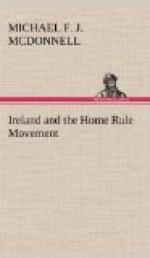The upshot was a Papal rescript, signed by Cardinal Simeoni, the Prefect, and Mgr. Jacobini, the Secretary of the Sacred Congregation De Propagatione Fide, which condemned the Tribute owing to the Land League agitation.
“The collection called ‘The Parnell Testimonial Fund,’” so ran the rescript, “cannot be approved, and consequently it cannot be tolerated that any ecclesiastic, much less a bishop, should take any part whatever in recommending or promoting it.”
The bishops and clergy withdrew from any further action in connection with the Tribute Fund, but the laity gave the lie to the suggestion that they are under the thumb of their priests in matters which are not within the sphere of faith or morals. The rescript was promulgated in May, and at this time the subscription list amounted to less than L8,000. Within a month it had doubled, and by the end of the year it amounted to L37,000. The amount of the mortgage was L13,000. As Parnell, in a characteristically laconic way, put it in his evidence before the Commission, “The Irish people raised a collection for me to pay off the amount of a mortgage. The amount of the collection considerably exceeded the amount necessary.” The retort of the country to the document “Qualecumque de Parnellio,” had been, in the phrase then current, to “make Peter’s pence into Parnell’s pounds.”
Two years after the Simeoni letter Mr. Errington was again in Rome, attempting this time to secure the exclusion from the successorship to Cardinal M’Cabe, of Dr. Walsh of Maynooth, as Archbishop of Dublin. A letter on the subject fell into the hands of the editor of United Ireland, who published it in his paper, and so in this way thwarted the objects of the second Errington mission. “If we want to hold Ireland by force,” said Joseph Cowen, the Radical member for Newcastle, “let us do it ourselves; let us not call in the Pope, whom we are always attacking, to help us.”




